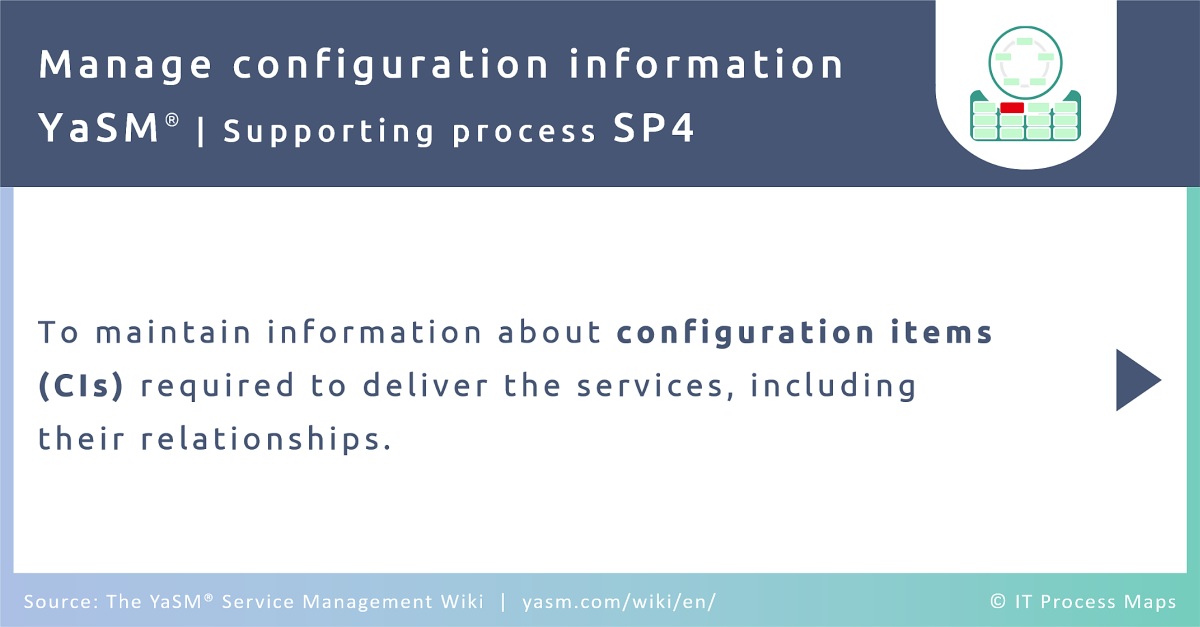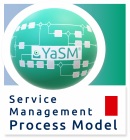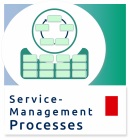SP4: Manage configuration information
Process name: Manage configuration information - Part of: Supporting processes
Previous process: Manage customer relationships
Next process: Assess and coordinate changes
Process description
The configuration management process in YaSM (fig. 1) ensures that up-to-date and reliable configuration information is available for the other service management processes. To this end, the process maintains a configuration model, which defines the types of items (referred to as 'configuration items' or 'CIs') to be managed through the configuration management system (CMS).
Once the configuration model is defined and the CMS configured accordingly, control can be exercised over all updates to the CI records in the CMS, for example by specifying who is authorized to make particular types of changes in the CMS and by reviewing updates to the CMS.
The information in the CMS is also subjected to regular audits in order to ensure that it is an exact representation of the configuration items in the live productive environment.
Configuration information is an important input for virtually every YaSM process. For example, it is essential for the resolution of incidents and problems to know precisely what types and versions of infrastructure items are installed.
Compatibility: The YaSM configuration management process is aligned with ISO 20000, the international standard for service management (see ISO/IEC 20000-1:2018, section 8.2), and it corresponds to the practices of 'ITIL 4 service configuration management' and 'IT asset management'.
Sub-processes
YaSM configuration management has the following sub-processes:
- SP4.1: Support the management of configuration information
- Process objective: To set up and maintain the tools for an effective and efficient management of configuration items (CIs) and the related configuration information.
- SP4.2: Maintain the configuration model
- Process objective: To define and maintain the underlying structure of the CMS (the configuration model), so that it is able to hold all information on configuration items (CIs). This includes specifying the CI types' attributes and their sub-components, as well as the required types of relationships.
- SP4.3: Control configuration information
- Process objective: To ensure that no configuration items are added or modified without the required authorization, and that such modifications are adequately recorded in the CMS.
- SP4.4: Audit configuration information
- Process objective: To perform regular checks, ensuring that the information contained in the configuration management system (CMS) is an exact representation of the CIs actually installed in the live production environment.
Process outputs
This section lists the documents and records produced by 'configuration management'. YaSM data objects [*] are marked with an asterisk, while other objects are displayed in gray.
- Change record
- A change record contains all details of a change, documenting the lifecycle of a single change. In its initial state, a change record describes a request for change (RFC) which is to be assessed and authorized prior to implementing the change. Further information is added as the change progresses through its lifecycle. [*]
- Change status information
- Current status information related to the implementation of a change. This information is sent to the change manager from the various processes that implement authorized changes. It is used by the change manager to keep the change records and the change schedule up-to-date.
- CI record
- Configuration information is maintained in CI records for all configuration items (CIs) under the control of the configuration manager. In this context, CIs can be of various types: Applications, systems and other infrastructure components are treated as CIs, but often also services, policies, project documentation, employees, suppliers, etc. Configuration information is stored in the configuration management system (CMS). [*]
- Configuration audit report
- A report summarizing the results of a configuration audit, highlighting revealed differences between the CI records in the CMS and actually installed CIs. [*]
- Configuration model
- The configuration model defines the structure of the configuration management system (CMS). It specifies the types of configuration items (CIs) to be managed through the CMS, including their attributes. The configuration model is often maintained as a set of documents or a data model. It also manifests itself, for example, in the table structure of the database(s) used to store configuration information. [*]
- Request to change the configuration model
- A request from a service management process to change the configuration model. This request is sent to the configuration manager if new CIs or CI attributes must be documented in the CMS but the CMS's structure is not adequate for holding the new data.
- Suggested process modification
- A suggestion for modifying one or several service management processes. Suggestions for process modifications or improvements may originate from anywhere within the organization.
Notes:
[*] "YaSM data objects" are those documents or records for which the YaSM model provides detailed recommendations: Every YaSM object has an associated checklist (see example) describing its typical contents, and an associated lifecycle diagram depicting how the status of the object changes as it is created, updated, read and archived by various YaSM processes (see example).
"Other objects" are mostly informal data or information where YaSM has less strong views about their contents. There are no associated lifecycle diagrams or checklists.
Process metrics
Process metrics are used, for example, to assess if the service management processes are running according to expectations.
For suggestions of suitable metrics, please refer to the list of metrics for the YaSM configuration management process.
Roles and responsibilities
Process owner: The configuration manager is responsible for maintaining information about the infrastructure required to deliver the services. To this end he/ she maintains a logical model describing the components of the infrastructure and their associations.
| YaSM role / sub-process | Configuration manager | |
|---|---|---|
| SP4.1 | Support the management of config. information | AR |
| SP4.2 | Maintain the configuration model | AR |
| SP4.3 | Control configuration information | AR |
| SP4.4 | Audit configuration information | AR |
Notes
Is based on: The configuration management process from the YaSM Process Map.
By: Stefan Kempter ![]() and Andrea Kempter
and Andrea Kempter ![]() , IT Process Maps.
, IT Process Maps.
Process description › Sub-processes › Process outputs › Metrics › Roles





